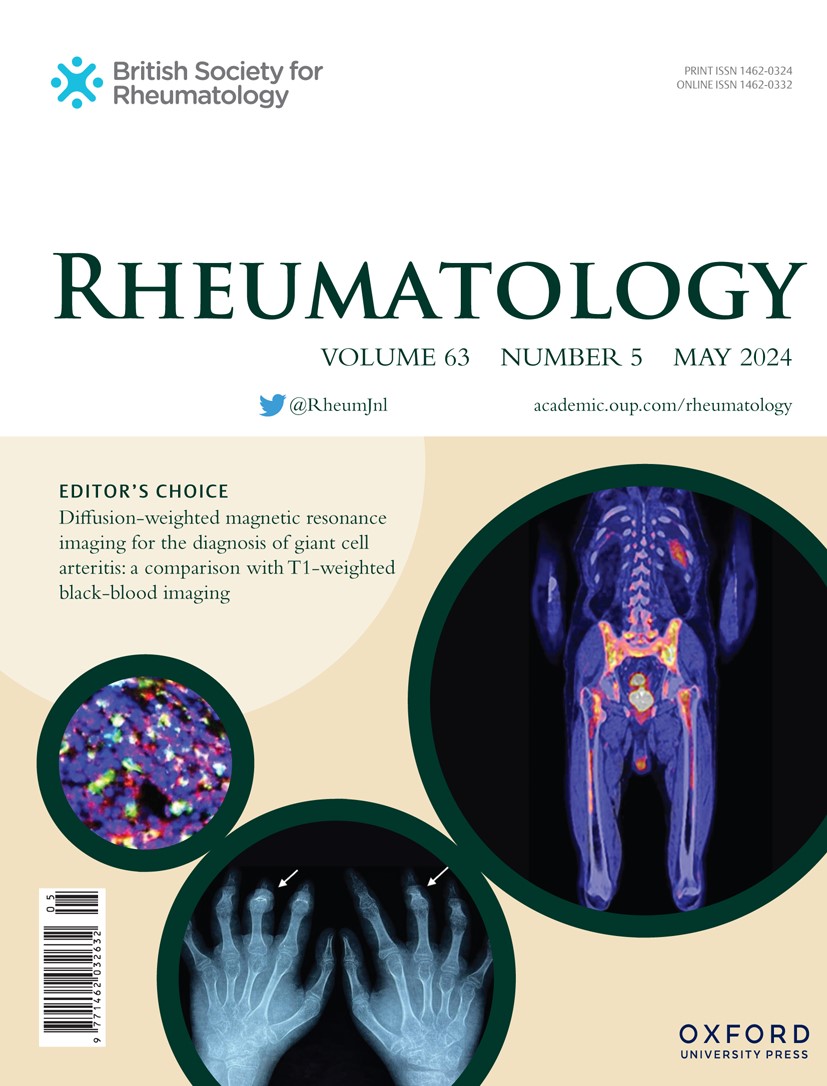OA33 A randomised controlled trial to assess the feasibility and acceptability of remote psychosocial and exercise interventions for people with lupus: the ADAPT feasibility trial
IF 4.7
2区 医学
Q1 RHEUMATOLOGY
引用次数: 0
Abstract
Background/Aims Limited support is available to help people adapt to living with lupus despite the highly reduced quality of life, and almost 50% of lupus patients having experienced suicidal thoughts. Reducing the high burden of symptoms through psychosocial and exercise interventions could lead to significant savings in healthcare costs, in addition to being life-improving for patients. The aim of this study was to assess the acceptability, feasibility and indications of effectiveness of psychosocial and exercise interventions to inform a large-scale definitive trial. Methods This study was a pre-registered randomised controlled trial (ISRCTN:72406488). Participants were SLE patients (N = 124). Participants were randomised to either a control arm or one of three interventions delivered remotely over 8-12 weeks: 1) The Wren project (providing listening support), 2) Pilates classes, and 3) supportive and educational texts/videos. Feasibility, acceptability, and effectiveness measures were collected through online surveys (at Baseline, 12 and 26 weeks) and qualitative interviews. Validated instruments included: depression (PHQ-8), fatigue (FACIT-F), resilience (CD-RISC) and our co-designed “ADAPT” measure. Progression criteria to a definitive trial were pre-defined. Hedge’s g and linear regression were used to estimate within and between-arm differences in effectiveness measures. Qualitative data were analysed using thematic analysis. Results Participants were mostly female (97%) and white (82%). We found high levels of feasibility for all interventions. Pre-defined acceptability criteria of > 75% rating the intervention as acceptable/highly acceptable were met for all interventions. The Pilates intervention had the highest proportion of withdrawals/non-attendance (primarily due to ill health). Satisfaction with Pilates was reported for both physical and mental health: “It was the first time I had the opportunity to engage with others with lupus which made me feel less alone. My body and mind feel stronger, and I have a higher sense of self-worth for taking part” (Ppt 001, 40’s), and The Wren participants particularly valued having a “safe space” to talk. Although the text/video programme was acceptable, feasible, and low cost to deliver, 41% of participants stated that they would rather have received a different intervention. Several areas of improvement for the text/video programme were suggested. This included greater tailoring, particularly to stage of disease journey as what was considered acceptable and helpful to a newly diagnosed participant was often viewed as patronising to more experienced patients. Estimates of effectiveness favoured the interventions compared to control, and there was evidence of improved resilience and depression (all interventions), and fatigue (Pilates). Conclusion All interventions were assessed as feasible and acceptable to progress to a large-scale definitive trial, although the text/video intervention requires improvements. A complex multi-stage intervention is required as individual interventions are unlikely to have a positive effect on all of the diverse areas requiring support for people with lupus and other rheumatological diseases. Disclosure M. Sloan: None. D. D’Cruz: Corporate appointments; Leadership position on the APS charity board. Consultancies; Consultancy/speaker fees from GSK, Eli Lilly, Vifor and UCB. T.A. Pollak: None. W. Diment: None. M. Bosley: None. E. Lever: None. F. Mann: None. B. Sloan: None. S. Morris: None. J. Brimicombe: None. F. Naughton: None.一项评估狼疮患者远程心理社会和运动干预的可行性和可接受性的随机对照试验:ADAPT可行性试验
背景/目的有限的支持可以帮助人们适应狼疮患者的生活,尽管生活质量大大降低,几乎50%的狼疮患者有过自杀念头。通过社会心理和运动干预措施减轻症状的沉重负担,除了可以改善患者的生活外,还可以大大节省医疗保健费用。本研究的目的是评估心理社会和运动干预的可接受性、可行性和有效性适应症,为大规模的确定试验提供信息。方法采用预注册随机对照试验(ISRCTN:72406488)。参与者为SLE患者(N = 124)。参与者被随机分配到对照组或远程提供的三种干预措施中的一种,为期8-12周:1)鹪鹩项目(提供听力支持),2)普拉提课程,以及3)支持性和教育性文本/视频。通过在线调查(基线、12周和26周)和定性访谈收集可行性、可接受性和有效性措施。经过验证的仪器包括:抑郁(PHQ-8)、疲劳(FACIT-F)、弹性(CD-RISC)和我们共同设计的“ADAPT”测量。预先定义了最终试验的进展标准。使用Hedge’s g和线性回归来估计有效性测量的组内和组间差异。定性数据采用专题分析进行分析。结果参与者以女性(97%)和白人(82%)居多。我们发现所有干预措施的可行性都很高。预先定义的&;gt;75%的人认为所有干预措施都是可接受/高度可接受的。普拉提干预有最高比例的退出/不出席(主要是由于健康不佳)。据报道,普拉提对身体和心理健康都很满意:“这是我第一次有机会与其他狼疮患者接触,这让我感到不那么孤独。我的身体和精神都感觉更强大了,参与其中我有了更高的自我价值感”(Ppt 001, 40年代),而且鹪鹩的参与者特别重视有一个“安全的空间”来交谈。尽管文本/视频方案是可接受的、可行的,而且交付成本低,但41%的参与者表示他们宁愿接受不同的干预。提出了文本/录象方案的几个改进领域。这包括更大程度的调整,特别是疾病阶段,因为对新诊断的参与者来说,被认为是可接受的和有帮助的,往往被认为是对更有经验的患者的光顾。与对照组相比,干预的有效性估计更有利,并且有证据表明,恢复力和抑郁(所有干预)以及疲劳(普拉提)得到了改善。尽管文本/视频干预需要改进,但所有干预措施都被评估为可行和可接受的,可以进行大规模的确定试验。由于个别干预不太可能对所有需要支持狼疮和其他风湿病患者的不同领域产生积极影响,因此需要复杂的多阶段干预。斯隆:没有。D. D 'Cruz:公司任命;APS慈善委员会的领导职位。咨询公司;葛兰素史克、礼来、Vifor和UCB的咨询/演讲费。波拉克:没有。W. d:没有。博斯利:没有。杠杆:没有。F. Mann:没有。B.斯隆:没有。莫里斯:没有。J. Brimicombe:没有。诺顿:没有。
本文章由计算机程序翻译,如有差异,请以英文原文为准。
求助全文
约1分钟内获得全文
求助全文
来源期刊

Rheumatology
医学-风湿病学
CiteScore
9.40
自引率
7.30%
发文量
1091
审稿时长
2 months
期刊介绍:
Rheumatology strives to support research and discovery by publishing the highest quality original scientific papers with a focus on basic, clinical and translational research. The journal’s subject areas cover a wide range of paediatric and adult rheumatological conditions from an international perspective. It is an official journal of the British Society for Rheumatology, published by Oxford University Press.
Rheumatology publishes original articles, reviews, editorials, guidelines, concise reports, meta-analyses, original case reports, clinical vignettes, letters and matters arising from published material. The journal takes pride in serving the global rheumatology community, with a focus on high societal impact in the form of podcasts, videos and extended social media presence, and utilizing metrics such as Altmetric. Keep up to date by following the journal on Twitter @RheumJnl.
 求助内容:
求助内容: 应助结果提醒方式:
应助结果提醒方式:


